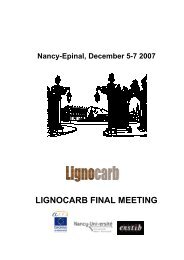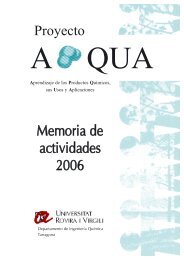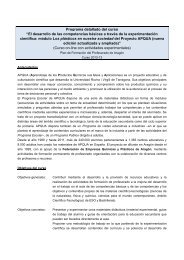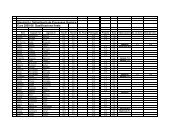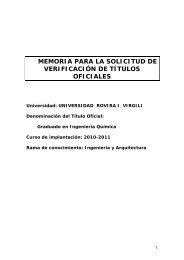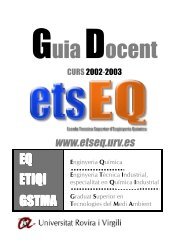A Transferable Force Field To Predict Phase Equilibria and Surface ...
A Transferable Force Field To Predict Phase Equilibria and Surface ...
A Transferable Force Field To Predict Phase Equilibria and Surface ...
You also want an ePaper? Increase the reach of your titles
YUMPU automatically turns print PDFs into web optimized ePapers that Google loves.
Received: April 8, 2011<br />
Revised: July 28, 2011<br />
Published: July 29, 2011<br />
ARTICLE<br />
pubs.acs.org/JPCB<br />
A <strong>Transferable</strong> <strong>Force</strong> <strong>Field</strong> <strong>To</strong> <strong>Predict</strong> <strong>Phase</strong> <strong>Equilibria</strong> <strong>and</strong> <strong>Surface</strong><br />
Tension of Ethers <strong>and</strong> Glycol Ethers<br />
Nicolas Ferr<strong>and</strong>o,* ,†,‡ Veronique Lachet, † Javier Perez-Pellitero, †,§ Allan D. Mackie, § Patrice Malfreyt, ^<br />
<strong>and</strong> Anne Boutin ||<br />
†<br />
IFP Energies Nouvelles, 1-4 avenue de Bois-Preau, 92852 Rueil-Malmaison, France<br />
‡<br />
Laboratoire de Chimie-Physique, CNRS, Universite Paris-Sud, b^at. 349, 91405 Orsay Cedex, France<br />
§<br />
Departament d'Enginyeria Química, ETSEQ, Universitat Rovira i Virgili, Avinguda dels Pa€isos Catalans, 26 Campus Sescelades,<br />
43007 Tarragona, Spain<br />
^<br />
Clermont Universite, Universite Blaise Pascal, Laboratoire de Thermodynamique et Interactions Moleculaires, UMR CNRS 6272,<br />
BP 10448, F-63000, Clermont-Ferr<strong>and</strong>, France<br />
Ecole Normale Superieure, Departement de Chimie, UMR 8640, CNRS-ENS-UPMC, 24, rue Lhomond, 75005 Paris, France<br />
bS Supporting Information<br />
)<br />
ABSTRACT: We propose a new transferable force field to simulate phase<br />
equilibrium <strong>and</strong> interfacial properties of systems involving ethers <strong>and</strong> glycol ethers.<br />
On the basis of the anisotropic united-atom force field, only one new group is<br />
introduced: the ether oxygen atom. The optimized Lennard Jones (LJ) parameters<br />
of this atom are identical whatever the molecule simulated (linear ether,<br />
branched ether, cyclic ether, aromatic ether, diether, or glycol ether). Accurate<br />
predictions are achieved for pure compound saturated properties, critical properties,<br />
<strong>and</strong> surface tensions of the liquid vapor interface, as well as for pressure<br />
composition binary mixture diagrams. Multifunctional molecules (1,2-dimethoxyethane,<br />
2-methoxyethanol, diethylene glycol) have also been studied using a<br />
recently proposed methodology for the calculation of the intramolecular electrostatic<br />
energy avoiding the use of additional empirical parameters. This new force field appears transferable for a wide variety of<br />
molecules <strong>and</strong> properties. It is furthermore worth noticing that binary mixtures have been simulated without introducing empirical<br />
binary parameters, highlighting also the transferability to mixtures. Hence, this new force field gives future opportunities to simulate<br />
complex systems of industrial interest involving molecules with ether functions.<br />
1. INTRODUCTION<br />
Because of their various applications as solvents in biochemistry<br />
<strong>and</strong> organic chemistry, there is considerable interest in the<br />
thermophysical properties of ethers. Aliphatic <strong>and</strong> cyclic ethers<br />
are used as solvents or cosolvents in chromatographic stationary<br />
phases, organic synthesis, <strong>and</strong> supercritical fluids. Ethers are also<br />
involved in a large variety of industrial processes in the oil <strong>and</strong> gas<br />
industry. Cyclic ethers such as tetrahydrofuran (THF) are<br />
particularly suitable for hydrate-based gas separations since they<br />
can be added to promote clathrate hydrate formation. 1 Multifunctional<br />
ethers such as glycol ethers are involved in gas<br />
sweetening <strong>and</strong> dehydration processes. 2,3 The production of<br />
biofuels by incorporating aliphatic ethers to classical fuels, such<br />
as dimethyl ether in liquefied petroleum 4 or diethyl ether in<br />
diesel, 5 is also of primary interest nowadays. All of these<br />
applications require a good knowledge of phase equilibrium<br />
<strong>and</strong> phase properties of both pure fluids <strong>and</strong> mixtures involving<br />
this class of oxygenated compounds. Reliable <strong>and</strong> predictive<br />
models are thus needed in this context.<br />
In the last few years, transferable united-atom force fields have<br />
been developed to make molecular simulation an efficient tool to<br />
predict equilibrium properties of pure fluids <strong>and</strong> mixtures with an<br />
acceptable precision <strong>and</strong> a reduced computational time. 6 However,<br />
transferable united-atom force fields for ethers are relatively<br />
scarce in literature. The OPLS-UA force field (Optimized<br />
Potential for Liquid Simulations) developed by Briggs et al. for<br />
dimethyl, ethyl methyl, <strong>and</strong> diethyl ether was proposed to<br />
reproduce thermodynamic quantities near room temperature<br />
<strong>and</strong> pressure. 7 Far away from these conditions, this model<br />
becomes less accurate, <strong>and</strong> the transferability to other ethers is<br />
questionable. <strong>To</strong> account for a better <strong>and</strong> more general description,<br />
Stubbs et al. proposed an extension of the TraPPE-UA force<br />
field (TRAnsferable Potentials for <strong>Phase</strong> <strong>Equilibria</strong>) based on the<br />
development of parameters for the ether oxygen atom combined<br />
with previously optimized parameters for the rest of the<br />
molecule. 8 The simulation of glycol ether molecules is however<br />
restrained to the use of a specific intramolecular repulsion potential<br />
making this approach less transferable for multifunctional molecules.<br />
r 2011 American Chemical Society 10654 dx.doi.org/10.1021/jp203278t | J. Phys. Chem. B 2011, 115, 10654–10664
The Journal of Physical Chemistry B ARTICLE<br />
Table 1. Non-bonded Parameters for the AUA4 <strong>Force</strong> <strong>Field</strong><br />
In this work, we propose to extend the transferable AUA4 potential 9<br />
to ethers by introducing a single new atom corresponding to the<br />
ether oxygen. For the shake of transferability, all of the other<br />
groups are taken from previous parametrizations of the AUA4<br />
force field (see ref 6 for a review), <strong>and</strong> the new Lennard Jones<br />
(LJ) parameters of the oxygen force center proposed in this<br />
work are the same whatever the ether simulated. <strong>To</strong> highlight<br />
the transferability of the developed force field, various families<br />
of ethers are studied (linear, branched, cyclic, aromatic,<br />
diethers, <strong>and</strong> glycol ethers). At the same time, binary mixtures<br />
with hydrocarbons <strong>and</strong> alcohols are considered. In addition to<br />
the prediction of classical saturated phase properties, we also<br />
calculate the liquid vapor surface tension of dimethyl ether<br />
using the new force field.<br />
This paper is organized as follows: the proposed force field is<br />
described in Section 2. The simulation methods used to calculate<br />
phase equilibrium <strong>and</strong> interfacial properties of pure compounds<br />
<strong>and</strong> binary mixtures are detailed in Section 3. Section 4 presents<br />
the results obtained for saturated properties, liquid phase structure,<br />
<strong>and</strong> surface tension predictions of a wide variety of pure<br />
ethers as well as phase diagrams of mixtures. Finally, Section 5<br />
gives our conclusions.<br />
2. FORCE FIELD DEVELOPMENT<br />
2.1. Intermolecular Energy. 2.1.1. Dispersive-Repulsive Energy.<br />
The dispersive-repulsive intermolecular interactions between two<br />
force centers i <strong>and</strong> j are described through a 12-6 LJ potential:<br />
U LJ<br />
ij ¼ 4εij<br />
atom ε (K) σ (Å) δ (Å) q (e)<br />
CH3 ( CHx) 120.15 3.607 0.216 0<br />
CH3 ( Oether) 120.15 3.607 0.216 +0.223<br />
(dimethyl ether <strong>and</strong> multifunctional ethers); +0.185<br />
(linear <strong>and</strong> branched monoethers)<br />
(CHx )CH2linear ( CHx) 86.29 3.461 0.384 0<br />
(CHx )CH2linear ( Oether) 86.29 3.461 0.384 +0.223<br />
(dimethyl ether <strong>and</strong> multifunctional ethers); +0.185<br />
(linear <strong>and</strong> branched monoethers)<br />
(CH x )CH 2linear ( O alcohol) 86.29 3.461 0.384 +0.265<br />
(CH2cyc )CH2cyc( CH2cyc) 90.09 3.461 0.336 0<br />
(CH2cyc )CH2cyc( Oether) 90.09 3.461 0.336 +0.295<br />
(CHx )CH aliph( Oether) 50.98 3.363 0.646 +0.185<br />
(CHx )C aliph( Oether) 15.04 2.44 0 +0.185<br />
CHarom 89.40 3.246 0.407 0<br />
Carom( Oether) 37.70 3.246 0 +0.223<br />
Oalcohol 125.01 3.081 0.01 0.700<br />
Halcohol 0 0 0 +0.435<br />
Oether 59.69 2.991 0 0.446<br />
(dimethyl ether, aromatic ethers, <strong>and</strong> multifunctional ethers); 0.370<br />
(linear <strong>and</strong> branched monoethers); 0.590 (cyclic ethers)<br />
2<br />
4<br />
σij<br />
rij<br />
! 12<br />
σij<br />
rij<br />
! 6<br />
3<br />
5 ð1Þ<br />
where rij, εij,<strong>and</strong>σij are the distance, the LJ well depth, <strong>and</strong> the LJ<br />
size, respectively.<br />
Cross LJ parameters are obtained using Lorentz<br />
combining rules:<br />
Berthelot<br />
εij ¼ ffiffiffiffiffiffiffiffi p<br />
εiiεjj<br />
ð2Þ<br />
σij ¼ 1<br />
2 ðσii þ σjjÞ ð3Þ<br />
All of the LJ parameters involved in the hydrocarbonated <strong>and</strong><br />
hydroxyl parts of the molecules studied in this work are taken<br />
without any modification from the AUA4 potential for<br />
hydrocarbons 9 12 <strong>and</strong> alcohols. 13 The totality of the parameters<br />
are summarized in Table 1. In the AUA model, the LJ center is<br />
not located on the atomic nuclei of the group but slightly shifted<br />
by a distance δ (AUA displacement) to implicitly take into<br />
account the presence of its bonded hydrogen atoms. In this work,<br />
a single new force center is introduced for the ether oxygen atom.<br />
Since no AUA displacement is required in the case of this center<br />
of force, the only parameters to be adjusted are the LJ parameters<br />
σ0 <strong>and</strong> ε0.<br />
The optimization procedure applied for the LJ parameters<br />
used in this work has been described elsewhere. 14 It consists in<br />
minimizing the mean square relative deviation F between<br />
experimental <strong>and</strong> calculated properties Xi:<br />
F ¼ 1<br />
n ∑n<br />
ðX<br />
i ¼ 1<br />
calc<br />
i<br />
X exp<br />
i Þ 2<br />
si 2<br />
10655 dx.doi.org/10.1021/jp203278t |J. Phys. Chem. B 2011, 115, 10654–10664<br />
ð4Þ<br />
where n denotes the total number of target values <strong>and</strong> s the sum<br />
of statistical <strong>and</strong> experimental uncertainties for a given property.<br />
The properties used in this adjustment procedure are the<br />
saturated liquid density, vapor pressure, <strong>and</strong> vaporization enthalpy<br />
of ethyl methyl ether at temperatures of 280 <strong>and</strong> 420 K.<br />
The experimental associated uncertainties are 1.5%, 5%, <strong>and</strong> 2%,<br />
respectively. This compound has been selected due to the fact<br />
that it includes both CH2 <strong>and</strong> CH3 neighboring ether group<br />
effects. The final optimized LJ parameters are given in Table 1.
The Journal of Physical Chemistry B ARTICLE<br />
Figure 1. Schematic representation of the ether function in the<br />
proposed molecular model. q1, q2, <strong>and</strong> q3 st<strong>and</strong> for the partial electrostatic<br />
charges located on the carbon <strong>and</strong> oxygen atoms.<br />
Figure 2. Experimental 15 gas phase dipole moments of ethers (diamonds:<br />
linear ethers, squares: branched ethers, circles: aromatic ethers, triangles:<br />
cyclic ethers).<br />
2.1.2. Electrostatic Energy. The electrostatic interaction between<br />
two partial electrostatic charges i <strong>and</strong> j is modeled by the<br />
Coulomb potential:<br />
U elec<br />
ij<br />
¼ qiqj<br />
4πε0rij<br />
ð5Þ<br />
where rij is the distance between charges i <strong>and</strong> j, qi the magnitude<br />
of charge i, <strong>and</strong> ε0 the vacuum permittivity.<br />
We adopt a three partial charge distribution involving one<br />
negative charge located on the oxygen atom <strong>and</strong> two symmetric<br />
positive charges on the bonded carbonated groups (see illustration<br />
in Figure 1). Concerning the magnitude of these charges, the<br />
use of a unique set of charges for the totality of the studied ether<br />
molecules is questionable. The transferability of electrostatic<br />
charges is justified as long as all studied molecules have a similar<br />
dipole moment. Figure 2 shows the evolution of the experimental<br />
gas phase dipole moment of various linear, branched, cyclic <strong>and</strong><br />
aromatic ethers in function of the number of carbon atoms. 15 In<br />
light of this graph, we propose to split the molecules in three<br />
groups. The first group (denoted further as group 1) contains<br />
branched <strong>and</strong> linear ethers (except dimethyl ether). The second<br />
group (group 2) contains dimethyl ether <strong>and</strong> aromatic ethers,<br />
<strong>and</strong> finally the third group (group 3) is constituted by cyclic<br />
ethers. Consequently, three different sets of partial electrostatic<br />
charges are proposed. It is well-known that the dipole moment of<br />
a polarizable molecule significantly differs between the gas phase<br />
<strong>and</strong> the liquid phase, <strong>and</strong> it is widely admitted that molecular<br />
models yield better results for phase equilibrium prediction when<br />
using the liquid phase dipole moment. 16 Hence, to determine the<br />
magnitude of the three sets of charges, we adopt a procedure<br />
similar to that described by Eckl et al.: 17,18 an ab initio calculation<br />
is performed by placing a molecule in a dielectric medium whose<br />
Table 2. Bonded Parameters for the AUA4 <strong>Force</strong> <strong>Field</strong><br />
bond length r0 (Å)<br />
CHx—CHy CHx—Oether/alcohol 1.535<br />
1.43<br />
1.36<br />
Carom—Oether CaromdCarom<br />
1.40<br />
Oalcohol—H 0.945<br />
bend θ0 (deg) kbend (K)<br />
CHx—CH2—CHy 114.0 74900<br />
CHx—CH2—Oether/alcohol 109.47 59800<br />
CHx—CH —Oether 112.0 57500<br />
CHx—C—Oether 112.0 57500<br />
CH x—O ether—CH y 112.0 69000<br />
CHaromdCHaromdCHarom 120.0 rigid<br />
CHaromdCarom—Oether/alcohol 120.0 rigid<br />
Carom—Oether—CHx 112.0 69000<br />
CHx—Oalcohol—H 108.5 61000<br />
torsion ai (K)<br />
CHx—CH2—CH2—CHy a0 = 1001.35 a1 = 2129.52<br />
a2 = 303.06 a3 = 3612.27<br />
a4 = 2226.71 a5 = 1965.93<br />
a6 = 4489.34 a7 = 1736.22<br />
a8 = 2817.37<br />
CHx—CH2—CH2—Oether a0 = 839.87 a1 = 2133.17<br />
a2 = 106.68 a3 = 3079.72<br />
CHx—CH2—CH2—Oalcohol a0 = 839.87 a1 = 2133.17<br />
a2 = 106.68 a3 = 3079.72<br />
CHx—CH2—Oether—CHy a0 = 956.05 a1 = 949.25<br />
a2 = 327.50 a3 = 2232.80<br />
CHx—CH2—Oether—Carom a0 = 956.05 a1 = 949.25<br />
a2 = 327.50 a3 = 2232.80<br />
CH3—CH—Oether—CHy a0 = 373.05 a1 = 919.04<br />
a2 = 268.15 a3 = 1737.21<br />
CH3—C—Oether—CHy a0 = 230.65 a1 = 691.92<br />
CHaromdCHaromdCHaromdCHarom rigid<br />
CHaromdCHaromdCarom—Oether/alcohol rigid<br />
a 2 =0 a 3 = 922.58<br />
rigid<br />
OalcoholdCaromdCarom—Oether<br />
CaromdCarom—Oalcohol—H a0 = 845.65 a1 =0<br />
a2 = 845.65 a3 =0<br />
CHaromdCarom—Oether—CHx a0 = 1631.27 a1 = 2651.77<br />
a2 = 868.86 a3 = 2184.14<br />
a4 = 3028.37 a5 = 3065.12<br />
a6 = 1926.79 a7 = 1723.03<br />
a8 = 497.96<br />
Oether—CH2—CH2—Oether a0 = 586.06 a1 = 2775.61<br />
a2 = 2496.45 a3 = 2542.12<br />
a 4 = 3132.43 a 5 = 2249.38<br />
a6 = 4188.47 a7 = 1318.58<br />
a 8 = 2316.03<br />
CH2—CH2—Oalcohol—H a0 = 339.41 a1 = 353.97<br />
a2 = 58.34 a3 = 751.72<br />
Oether—CH2—CH2—Oalcohol a0 = 1530.22 a1 = 4064.26<br />
a2 = 422.78 a3 = 5570.19<br />
10656 dx.doi.org/10.1021/jp203278t |J. Phys. Chem. B 2011, 115, 10654–10664
The Journal of Physical Chemistry B ARTICLE<br />
Table 2. Continued<br />
torsion a i (K)<br />
a4 = 772.20 a5 = 1110.27<br />
a6 = 174.93 a7 = 430.66<br />
a8 = 534.83<br />
dielectric constant is equal to that of the neat liquid of the given<br />
molecule, <strong>and</strong> the magnitude of the partial charges are adjusted to<br />
reproduce the obtained dipole moment. Preliminary ab initio<br />
calculations using the Jaguar software (v.7.0, Schr€odinger LLC,<br />
2007) have shown that the B3LYP/6-311G** level of theory<br />
gives an accurate prediction of experimental gas phase dipole<br />
moments (see Figure S1 in the Supporting Information). Hence,<br />
this level of theory is used for the calculation in the dielectric<br />
medium. Three calculations are performed: the first one with a<br />
molecule of diethyl ether (dielectric constant of 4.27) for the<br />
determination of group 1 charges, the second one with a<br />
molecule of dimethyl ether (dielectric constant of 6.18) for<br />
group 2 charges, <strong>and</strong> the third one with a molecule of THF<br />
(tetrahydrofuran, dielectric constant of 7.52) for group 3 charges.<br />
The resulting liquid phase dipole moments are 1.43 D, 1.69 D,<br />
<strong>and</strong> 2.32 D, respectively, which corresponds to increases from 25<br />
to 40% compared to their respective experimental gas phase<br />
dipole moments. The resulting electrostatic charges are reported<br />
in Table 1.<br />
<strong>To</strong> simulate oxygenated multifunctional molecules involving<br />
an ether function (1,2-dimethoxyethane, 2-methoxyethanol,<br />
diethylene glycol), we take advantage of the transferability of<br />
the force field <strong>and</strong> directly use the LJ parameters <strong>and</strong> partial<br />
charges of monoethers without any readjustment. The choice of<br />
the set of electrostatic charges to be used (group 1 or group 2) is<br />
not evident in some cases. <strong>To</strong> determine which set of charges is<br />
the most appropriate, ab initio calculations in a dielectric medium<br />
have been carried out to determine the liquid phase dipole<br />
moment of 1,2-dimethoxyethane (dielectric constant of 7.3),<br />
2-methoxyethanol (dielectric constant of 16.98), <strong>and</strong> diethylene<br />
glycol (dielectric constant of 31.82) in their most stable conformations.<br />
Then, the dipole moments are calculated using both<br />
sets of charges <strong>and</strong> compared to the ab initio value. Results are<br />
detailed in Supporting Information (Table S1) <strong>and</strong> show that the<br />
group 2 set of charges yields a better restitution of the ab initio<br />
liquid phase dipole moment. This set of charges will be thus<br />
systematically used to model multifunctional molecules.<br />
2.2. Intramolecular Energy. All of the bonded parameters<br />
involved in the intramolecular energy calculation are given in<br />
Table 2. In the proposed force field, all bond lengths are kept<br />
fixed. The CHx Oether bond length is chosen equal to the<br />
CH x O alcohol bond length used in the parametrization of the<br />
force field for alcohols. 13 The Carom Oether bond length encountered<br />
in anisole is taken from Lide. 19 The rest of bond<br />
lengths are taken from the AUA4 force field. 6 Atoms separated by<br />
two bonds interact via a harmonic bending potential:<br />
Ubend<br />
¼<br />
kB<br />
1<br />
2 kbendðcos θ cos θ0Þ 2<br />
ð6Þ<br />
where kB is the Boltzmann constant, kbend the bending constant,<br />
<strong>and</strong> θ <strong>and</strong> θ0 the bending angle <strong>and</strong> the equilibrium bending<br />
angle, respectively. The bending parameters involving the ether<br />
oxygen atom are taken from the AMBER force field, 20 whereas all<br />
other bending parameters are taken from the AUA4 force field.<br />
Figure 3. <strong>To</strong>rsion energy as a function of the dihedral angle. The<br />
convention used is that a dihedral angle equal to 0 corresponds to a trans<br />
conformation. Symbols denote data derived from ab initio calculations,<br />
while solid lines are the corresponding fittings to eq 7. (a) CHaromd<br />
Carom—Oether—CH3 in anisole (ab initio data correspond to the sum of<br />
the two torsions of this type encountered in anisole assuming a shift of<br />
180° between the two dihedral angles; the dashed line corresponds to<br />
the fit of the sum of the two torsions). (b) Oether—CH2—CH2—Oether<br />
in 1,2-dimethoxyethane.<br />
For atoms separated by three bonds, a torsion potential of the<br />
following form is used:<br />
Utors<br />
¼ ∑ kB<br />
8<br />
n ¼ 0<br />
anðcos jÞ n<br />
10657 dx.doi.org/10.1021/jp203278t |J. Phys. Chem. B 2011, 115, 10654–10664<br />
ð7Þ<br />
where j is the dihedral angle <strong>and</strong> ai the ith torsion parameter. If<br />
available, the torsion parameters are taken from the OPLS-UA<br />
force field. 7 The missing torsions CH3—CH—Oether—CHx <strong>and</strong><br />
CH3—C—Oether—CHx encountered in ethylisopropyl ether<br />
<strong>and</strong> in ETBE (ethyl tert-butyl ether) are assumed to be identical<br />
to the AUA4 CH3—CH—CH2—CHx <strong>and</strong> CH3—C—CH2—<br />
CHx torsions, respectively. 10,21 The Oether—CH2—CH2—<br />
O alcohol torsion is assumed identical to the O alcohol—CH 2—<br />
CH2—Oalcohol torsion encountered in 1,2-ethanediol. 13 The<br />
CHaromdCarom—Oether—CHx torsion encountered in anisole<br />
is determined as follows. Ab initio calculations have been carried<br />
out on an isolated anisole molecule using the Jaguar software<br />
(v.7.0, Schr€odinger LLC, 2007), with the MP2 method <strong>and</strong><br />
6-311G** basis set. The energy was obtained for the whole range<br />
of the CH aromdC arom—O ether—CH 3 torsion angle, from 0 to<br />
360°, with increments of 10°. For each configuration, the<br />
contribution of bending <strong>and</strong> intramolecular LJ energies are<br />
subtracted from the total ab initio energy. Thus, the resulting
The Journal of Physical Chemistry B ARTICLE<br />
energy corresponds to the missing torsion potential, <strong>and</strong> it is<br />
fitted according to eq 7. Finally, the O ether—CH 2—CH 2—O ether<br />
torsion encountered in 1,2-dimethoxyethane is determined from<br />
quantum calculations in the same manner. The torsion potentials<br />
determined in this work are plotted in Figure 3.<br />
For the multifunctional molecules studied in this work,<br />
intramolecular electrostatic energy is taken into account following<br />
a previously described methodology employed for polyhydric<br />
alcohols. 13 The Coulomb law is applied between electrostatic<br />
charges belonging to the different local dipoles of the molecule,<br />
even if charges are located on bonded atoms (note that the<br />
torsion potential determinations are carried out in accordance<br />
with this methodology). The description of the existing local<br />
dipoles of the studied molecules is given in the Supporting<br />
Information (Figure S2).<br />
Finally, a 12-6 LJ potential is used to calculate repulsive<br />
dispersive intramolecular energy between two force centers<br />
separated by more than three bonds with identical parameters<br />
to those used for intermolecular interactions. As already pointed<br />
out in a previous work, 13 it is also necessary to apply this<br />
contribution between an hydroxyl oxygen atom <strong>and</strong> any other<br />
oxygen atom separated by exactly three bonds (in this work, it is<br />
the case for 2-methoxyethanol <strong>and</strong> diethylene glycol for which<br />
1 4 oxygen oxygen interaction exits), to avoid a too-strong<br />
attraction between the hydroxyl hydrogen atom, not surrounded<br />
by a LJ sphere, <strong>and</strong> the other oxygen atom.<br />
3. SIMULATION METHODS<br />
3.1. <strong>Phase</strong> <strong>Equilibria</strong>. All of the bulk liquid vapor equilibrium<br />
simulations of pure compounds were carried out in the<br />
NVT Gibbs ensemble. 22,23 In this ensemble, the two phases in<br />
equilibrium are introduced in two separate boxes without an<br />
explicit interface. When employed to study pure component<br />
equilibrium, this ensemble is applied at constant total volume of<br />
the two phases to respect the phase rule, the temperature <strong>and</strong><br />
the total number of molecules being also imposed. A total<br />
number of 300 molecules was used for each system, except in<br />
the vicinity of the critical point where larger systems were used<br />
(up to 500 molecules). For monofunctional ethers <strong>and</strong> 1,2dimethoxyethane,<br />
the simulation runs lasted for 50 million steps<br />
(involving an equilibration run of 25 million steps), one step<br />
corresponding to a single Monte Carlo (MC) move. The<br />
simulations of glycol ethers require longer equilibrium runs,<br />
<strong>and</strong> the statistical fluctuations observed are slightly more important,<br />
requiring thus also longer production runs to reduce<br />
statistical uncertainties. Hence, the simulation runs for glycol<br />
ethers lasted for 80 million steps involving an equilibration run of<br />
40 million steps. In the case of LJ interactions, a spherical cutoff<br />
equal to half of the simulation box was used while the classical tail<br />
correction was employed. 24 For long-range electrostatic energy,<br />
the Ewald summation technique was used, with a number of<br />
reciprocal vectors k equal to 7 in all three space directions <strong>and</strong> a<br />
Gaussian width R red equal to 2 in reduced units. This reduced<br />
parameter is related to the R parameter with:<br />
R ¼ R red π=L ð8Þ<br />
where L is the simulation box length.<br />
The different Monte Carlo moves <strong>and</strong> their correspondent<br />
attempt probabilities used during the simulations depend on the<br />
studied molecule <strong>and</strong> are summarized in the Supporting<br />
Information (Table S2). Note that the regrowth move is<br />
performed using the configurational bias. 25 For cyclic aliphatic<br />
molecules, the transfer moves involve a specific reservoir bias 11<br />
which allows us to sample the different conformations of the<br />
cycle. A high attempt probability is imposed for this transfer<br />
move since its acceptation ratio is low (0.5% at low reduced<br />
temperatures to 2% at high reduced temperatures). The amplitude<br />
of translations, rigid rotations, <strong>and</strong> volume changes was<br />
adjusted during the simulation to achieve an acceptance ratio of<br />
40% for these moves.<br />
The critical properties TC <strong>and</strong> FC of pure compounds were<br />
estimated by a least-squares fit of the law of rectilinear diameters:<br />
Fl þ Fv ¼ FC þ AðT TCÞ ð9Þ<br />
2<br />
where Fl <strong>and</strong> Fv are the density of the liquid <strong>and</strong> vapor phases,<br />
respectively, T the temperature, <strong>and</strong> A an adjustable parameter,<br />
<strong>and</strong> the critical scaling relation:<br />
F l F v ¼ BðT TCÞ β<br />
ð10Þ<br />
where B is another adjustable parameter <strong>and</strong> β the universal<br />
exponent, equal to 0.325. 25 This procedure works well for<br />
nonpolar molecules, but it has also been successfully applied<br />
for the prediction of the critical properties of polar molecules<br />
such as alcohols, ketones, <strong>and</strong> aldehydes. 13,26 Finally, the normal<br />
boiling temperatures of the pure compounds were determined<br />
using the Clausius Clapeyron equation. Note that vapor pressure<br />
is calculated using the virial equation in the vapor phase <strong>and</strong><br />
the molar vaporization enthalpy h vap with the following relation-<br />
ship:<br />
h vap ¼ Na<br />
ÆU vap æ<br />
ÆN vap æ<br />
ÆUliqæ ÆNliqæ þ Pvap ÆV vapæ ÆNvapæ ÆV liqæ ÆNliq ! !<br />
æ<br />
ð11Þ<br />
where N a is the Avogadro number, P vap the pressure calculated in<br />
the vapor phase, <strong>and</strong> ÆU i æ, ÆN i æ, <strong>and</strong> ÆV i æ the average potential<br />
energy, total number of molecules, <strong>and</strong> volume of phase i,<br />
respectively.<br />
For the binary mixtures studied in this work, simulations are<br />
performed in the bubble point pseudoensemble using the socalled<br />
hybrid method. 27,28 This methodology has already been<br />
successfully applied for nonpolar <strong>and</strong> polar mixtures with a good<br />
efficiency. 26,28,29 The liquid phase composition is kept fixed<br />
during the simulation, while pressure <strong>and</strong> vapor composition<br />
are given as results from the calculation. In the hybrid method, a<br />
first simulation in the bubble-point pseudoensemble (BPMC) is<br />
carried out, <strong>and</strong> then the obtained results are used to initialize a<br />
simulation in the isotherm-isochore Gibbs ensemble (GE-NVT)<br />
with the main goal of reducing the statistical uncertainty in the<br />
pressure calculation. Both BPMC <strong>and</strong> GE-NVT simulations<br />
lasted for 50 to 80 million MC steps, including an equilibrium<br />
run of 30 million steps. The initial number of molecules in the<br />
liquid phase was 400. All other simulation parameters are similar<br />
to those previously described for pure component systems.<br />
3.2. <strong>Surface</strong> Tension. <strong>To</strong> check the accuracy of the developed<br />
force field to predict interfacial properties, the surface tension γ<br />
of dimethyl ether has been calculated. The simulations have been<br />
carried out in the NVT ensemble in a rectangular parallelepipedic<br />
box. We have considered a system with two planar liquid vapor<br />
surfaces lying in the x,y-plane <strong>and</strong> the z-axis in the direction<br />
10658 dx.doi.org/10.1021/jp203278t |J. Phys. Chem. B 2011, 115, 10654–10664
The Journal of Physical Chemistry B ARTICLE<br />
normal to the surface (see Figure S5 in the Supporting Information).<br />
As the geometry of the system shows a heterogeneity<br />
along the axis normal to the interface (z-axis), we calculated the<br />
long-range correction to the repulsion-dispersion energy as a<br />
function of z k by splitting the cell into slabs. The total long-range<br />
correction energy ULRC was then calculated by summing up all of<br />
the local contributions of each slab. The ULRC term was then<br />
added in the total energy of the system to be used in the<br />
Metropolis scheme. This long-range correction to the LJ energy<br />
is defined by two parts: 30<br />
ULRC ¼ ∑ Ns<br />
ulrcðzkÞ ¼∑<br />
i ¼ 1<br />
Ns<br />
ðu<br />
i ¼ 1<br />
ð1Þ<br />
lrc ðzkÞ þu ð2Þ<br />
lrc ðzkÞÞ ð12Þ<br />
where Ns is the total number of slabs in the simulation box <strong>and</strong><br />
with:<br />
u ð1Þ<br />
lrc ðzkÞ ¼ 8π<br />
3 FðzkÞ 2 VS ∑ Ni<br />
∑<br />
a ¼ 1<br />
Nj<br />
εab 1=3<br />
b ¼ 1<br />
σ12 ab<br />
r9 !<br />
σ<br />
c<br />
6 ab<br />
r3 " ! #<br />
c<br />
u ð2Þ<br />
lrc ðzkÞ ¼πFðzkÞVS<br />
Z ∞<br />
rc<br />
ð13Þ<br />
Z r<br />
dr dΔz ∑<br />
r<br />
Ns<br />
½FðziÞ<br />
i ¼ 1<br />
Fðzi 1ÞŠrULJ, mðrÞ<br />
ð14Þ<br />
where Ns is the now the number of slabs between z <strong>and</strong> zk, F(zk)<br />
is the density of the slab k, <strong>and</strong> VS the volume of the slab. Ni is the<br />
number of force centers in molecule i, <strong>and</strong> ULJ,m is the intermolecular<br />
LJ energy with r being the distance between two<br />
centers of mass of molecules i <strong>and</strong> j. It has been shown 31 that the<br />
(2)<br />
second part of the long-range energy ulrc represents only a minor<br />
contribution to the total long-range energy. Therefore, it has not<br />
been considered in this work.<br />
Two different methods have been used to calculate surface<br />
tensions. The first one is the Irving Kirkwood (IK) method 32<br />
based on the mechanical definition of the surface tension <strong>and</strong><br />
requiring the calculation of the local tangential pT <strong>and</strong> normal pN<br />
components of the pressure tensor:<br />
Z Lz=2<br />
γIK ¼ 1<br />
½pNðzÞ pTðzÞŠdz ð15Þ<br />
2 Lz=2<br />
where Lz is the length of the simulation box along the z-axis. The<br />
components of the pressure tensor in the IK definition are<br />
expressed by:<br />
pRβðzkÞ ¼ÆFðzkÞækBTI þ 1<br />
A<br />
* ! ! +<br />
1<br />
N 1<br />
∑ ∑<br />
i ¼ 1<br />
N<br />
ðrijÞRðFijÞβ j>i jzijj θ zk zi<br />
zij<br />
θ zj zk<br />
zij<br />
ð16Þ<br />
where I is the unit tensor <strong>and</strong> T the input temperature. R <strong>and</strong> β<br />
represent x, y, orz directions. θ(z) is the unit step function<br />
defined by θ(x) = 0 when x < 0 <strong>and</strong> θ(x) = 1 when x g 0. A is the<br />
surface area normal to the z-axis. The distance zij between two<br />
molecular centers of mass is divided into Ns slabs of thickness δz.<br />
Following Irving <strong>and</strong> Kirkwood, the molecules i <strong>and</strong> j give a local<br />
contribution to the pressure tensor in a given slab k if the line<br />
joining the centers of mass of molecules i <strong>and</strong> j crosses, starts, or<br />
Figure 4. Experimental 15 (lines) <strong>and</strong> calculated (symbols) saturated<br />
liquid densities of linear ethers (a), branched, cyclic, <strong>and</strong> aromatic ethers<br />
(b), <strong>and</strong> multifunctional ethers (c).<br />
finishes in the slab k. Each slab has 1/N s of the total contribution<br />
from the i j interaction. The normal component pN (zk) is equal<br />
to pzz (zk), whereas the tangential component is given by 1/2<br />
(p xx(z k)+p yy(z k)). ÆF(z k)æ is the average density of the slab k. F ij<br />
is the intermolecular force between molecules i <strong>and</strong> j <strong>and</strong> is<br />
expressed as the sum of all of the site site forces acting between<br />
these two molecules.<br />
The second method used is the test-area (TA) method, 33<br />
based upon a thermodynamic route <strong>and</strong> expressing the surface<br />
tension as a change in the free energy F for a change in the surface<br />
area. This change in the area is performed through a perturbation<br />
process for which the perturbed system (state A + ΔA) is<br />
obtained from a change ΔA of the area A of the reference system.<br />
The box dimension (L x A+ΔA , Ly A+ΔA , Lz A+ΔA ) in the perturbed<br />
systems are changed using the following transformations:<br />
10659 dx.doi.org/10.1021/jp203278t |J. Phys. Chem. B 2011, 115, 10654–10664
The Journal of Physical Chemistry B ARTICLE<br />
Lx A+ΔA = Lx A (1 + ξ) 1/2 , Ly A+ΔA = Ly A (1 + ξ) 1/2 , <strong>and</strong> Lz A+ΔA = Lz A /<br />
(1 + ξ) where ξ f 0. The area (A + ΔA) of the perturbed state<br />
thus equals Lx A Ly A (1 + ξ), <strong>and</strong> ΔA is equal to Lx A Ly A ξ. These<br />
transformations conserve the volume of the box in the perturbed<br />
state. In this method, several simulations should in principle be<br />
repeated for different ξ values to correctly extrapolate the surface<br />
tension for ξ approaching zero. However, as recommended by<br />
Biscay et al. 34,35 we have performed one simulation with a ξ parameter<br />
equals to 5 10 4 since it has been shown to give correct<br />
surface tension. The operational expression for the calculation of<br />
γ within the TA method is:<br />
γ TA ¼ ∂F<br />
∂A N, V, T<br />
¼ ∑ k<br />
lim<br />
ξ f 0<br />
ðUðA þ ΔAÞðzk, r0NÞ UðAÞðzk, rN * ! +<br />
ÞÞ<br />
kBT<br />
k, A<br />
ð17Þ<br />
kBT<br />
ln exp<br />
ΔA<br />
Æ...æk,A indicates that the average is carried out over the reference<br />
state <strong>and</strong> the k slabs. U (A+ΔA) (zk,r 0N ) <strong>and</strong> U (A) (zk,r N )are<br />
the configurational energies of the slab k in the perturbed <strong>and</strong><br />
reference state.<br />
Tail corrections to the surface tension have also been accounted<br />
for using the expressions given by Biscay et al. 36 More<br />
detailed descriptions of these models <strong>and</strong> long-range corrections<br />
to be applied can be found elsewhere 31,37 42 <strong>and</strong> will be not<br />
discussed in this work. Note that both methods have been<br />
successfully applied with the AUA4 force field to calculate surface<br />
tensions of various hydrocarbons. 34,43<br />
The initial configuration of the system was prepared from<br />
equilibrated bulk liquid <strong>and</strong> bulk vapor phases, the bulk liquid<br />
phase (containing 750 molecules) being surrounded by two bulk<br />
vapor phases (containing each of them 10 molecules) along the<br />
z-axis. The Lx <strong>and</strong> Ly dimensions of the resulting simulation box<br />
are fixed to 30 Å, <strong>and</strong> the Lz dimension varies from 260 to 420 Å<br />
according to the temperature. The Ewald sum technique is used<br />
to calculate electrostatic energy, with a number of reciprocal<br />
vectors equal to 8 along the x- <strong>and</strong> y-axis <strong>and</strong> equal to (8L z)/L x<br />
along the z-axis. The Monte Carlo moves <strong>and</strong> their attempt<br />
probabilities used during the simulations are: translation<br />
(33.5%), rigid rotation (33.5%), <strong>and</strong> configurational-bias regrowth<br />
(33%). A typical simulation consists of an equilibration<br />
run followed by a production run of around 320 <strong>and</strong> 170 million<br />
steps, respectively.<br />
4. RESULTS<br />
4.1. <strong>Phase</strong> <strong>Equilibria</strong>. 4.1.1. Pure Compounds. Figures 4, 5,<br />
<strong>and</strong> 6 show respectively a comparison between experimental 15<br />
<strong>and</strong> calculated saturated liquid densities, vapor pressures, <strong>and</strong><br />
vaporization enthalpies. For each case different families of ethers<br />
are considered: linear ethers (dimethyl ether, ethylmethyl ether,<br />
diethyl ether, dipropyl ether), branched ethers (ethylisopropyl<br />
ether, ethyltertiobutyl ether (ETBE)), cyclic ethers (THF,<br />
tetrahydropyrane), aromatic ether (anisole), diether (1,2dimethoxyethane),<br />
<strong>and</strong> glycol ethers (2-methoxyethanol, diethylene<br />
glycol). Numerical values are provided in the Supporting<br />
Information (Table S3). The properties of monofunctional<br />
ethers are predicted with a good accuracy. Average deviations<br />
between calculated <strong>and</strong> experimental saturated liquid densities,<br />
vapor pressures, <strong>and</strong> vaporization enthalpies are 1.5%, 8%, <strong>and</strong><br />
Figure 5. Experimental 15 (lines) <strong>and</strong> calculated (symbols) vapor pressures<br />
of linear ethers (a), branched, cyclic, <strong>and</strong> aromatic ethers (b), <strong>and</strong><br />
multifunctional ethers (c).<br />
3%, respectively. These deviations are of the same order of<br />
magnitude as those obtained for their corresponding hydrocarbons<br />
with the AUA4 force field. The most important deviations<br />
are observed for the prediction of THF vapor pressures (23%).<br />
Similar deviations were also obtained when simulating the<br />
corresponding hydrocarbon (cyclopentane), 11 thus suggesting<br />
that the oxygen atom LJ parametrization or the electrostatic<br />
charge distribution is not the main reason for such a high<br />
deviation. Concerning tetrahydropyran, the average deviation<br />
on the vapor pressure (14%) is in better agreement than that of<br />
THF, as already observed for corresponding hydrocarbons<br />
(cyclohexane <strong>and</strong> cyclopentane). The vaporization enthalpy of<br />
tetrahydropyran is, however, slightly larger than that of cyclohexane<br />
(9% vs 4%).<br />
10660 dx.doi.org/10.1021/jp203278t |J. Phys. Chem. B 2011, 115, 10654–10664
The Journal of Physical Chemistry B ARTICLE<br />
Figure 6. Experimental 15 (lines) <strong>and</strong> calculated (symbols) vaporization<br />
enthalpies of linear ethers (a), branched, cyclic, <strong>and</strong> aromatic ethers (b),<br />
<strong>and</strong> multifunctional ethers (c).<br />
Concerning multifunctional ethers, a good agreement between<br />
experimental <strong>and</strong> calculated data is also observed since<br />
average deviations on saturated liquid densities, vapor pressures,<br />
<strong>and</strong> vaporization enthalpies are around 2%, 10%, <strong>and</strong> 3%,<br />
respectively. These results are particularly remarkable taking into<br />
account that no additional empirical parameters have been<br />
introduced to simulate such complex molecules, highlighting<br />
thus the transferability of the proposed force field. It can also be<br />
noticed that our new force field leads to a significant improvement<br />
in the pure compound vapor pressure prediction compared<br />
to the widespread TraPPE-UA force field, without altering the<br />
accuracy of the density prediction.<br />
Finally, Figure 7 shows results obtained for critical properties<br />
<strong>and</strong> normal boiling point prediction. Numerical values are given<br />
in Supporting Information (Table S4). A good accuracy is<br />
reached since the average deviations between calculated <strong>and</strong><br />
Figure 7. Average deviations between experimental 15 <strong>and</strong> calculated<br />
critical properties <strong>and</strong> normal boiling points. AAD(%) = abs(X calc<br />
X exp )/X exp<br />
100.<br />
Figure 8. Experimental 44,45 (lines) <strong>and</strong> calculated (symbols) pressure<br />
composition diagram of the diethyl ether + ethane mixture at 298.15 K<br />
(a) <strong>and</strong> diethyl ether + ethanol mixture at 323.15 K (b).<br />
experimental are around 2%, 3.5%, <strong>and</strong> 1% for the critical<br />
temperatures, the critical densities, <strong>and</strong> the normal boiling<br />
points, respectively. The higher deviation is obtained for the<br />
critical density of 1,2-dimethoxyethane (11%). Nevertheless,<br />
experimental uncertainties reported in the literature 15 for this<br />
property are particularly high (25%).<br />
The liquid phase structure of pure 2-methoxyethanol was also<br />
investigated at 298 K <strong>and</strong> 0.1 MPa. Intermolecular O hydroxyl<br />
Ohydroxyl <strong>and</strong> Oether Ohydroxyl radial distribution functions are<br />
given in the Supporting Information (Figure S3), <strong>and</strong> both<br />
10661 dx.doi.org/10.1021/jp203278t |J. Phys. Chem. B 2011, 115, 10654–10664
The Journal of Physical Chemistry B ARTICLE<br />
Figure 9. <strong>Surface</strong> tensions of the liquid vapor interface of dimethyl<br />
ether. Solid line: experimental data, 46 squares: calculated with the IK<br />
method, triangles: calculated with the TA method.<br />
Table 3. Experimental 46 (Smoothed) <strong>and</strong> Calculated (with<br />
IK <strong>and</strong> TA Methods) Liquid Vapor <strong>Surface</strong> Tensions of<br />
Dimethyl Ether a<br />
T (K) γexp (mN/m)<br />
γIK (mN/m) γTA (mN/m)<br />
total LRC total LRC<br />
260 17.35 18.611 3.21 19.713 2.21<br />
280 14.40 15.320 2.91 16.421 2.11<br />
300 11.55 12.517 2.51 13.617 1.81<br />
320 8.81 10.113 2.11 11.114 1.51<br />
340 6.18 6.5313 1.51 7.5514 1.31<br />
a<br />
The subscripts give the accuracy of the last decimal, i.e., 18.611 means<br />
18.6 ( 1.1. The LRC columns give the contribution of the long range<br />
corrections to the total value of surface tension.<br />
exhibit a peak located at 2.8 Å. At the intramolecular level, the<br />
Oether Hhydroxyl histogram exhibits three peaks at 2.6, 3.9, <strong>and</strong><br />
4.3 Å corresponding to three stable conformations detailed in<br />
Figure S4 in the Supporting Information.<br />
4.1.2. Binary Mixtures. Two binary mixtures are studied in this<br />
work: a polar + nonpolar system (diethyl ether + ethane at<br />
298.15 K) <strong>and</strong> a polar + polar system (diethyl ether + ethanol at<br />
323.15 K). In Figure 8 simulation results are compared to<br />
experimental data. 44,45 A good agreement between experiments<br />
<strong>and</strong> simulations is observed: deviations on bubble pressures are<br />
around 5 <strong>and</strong> 8%, respectively, while for the case of the vapor<br />
phase compositions, deviations are 15 <strong>and</strong> 6%, respectively. It is<br />
worth noticing that no modification of the force field has been<br />
carried out to simulate these mixtures: the same combining rules<br />
without introduction of empirical binary interaction parameters<br />
are employed. Such results emphasize thus the transferability of<br />
the developed force field to mixtures.<br />
4.2. Liquid Vapor <strong>Surface</strong> Tension. Experimental 46 <strong>and</strong><br />
calculated liquid vapor surface tensions of dimethyl ether are<br />
plotted in Figure 9, while numerical values are reported in<br />
Table 3. In this table are also reported the contributions of longrange<br />
corrections to the total surface tension values. <strong>Surface</strong><br />
tensions <strong>and</strong> pN pT profiles along the z-axis are given in the<br />
Supporting Information (Figure S6) as well as a snapshot of the<br />
liquid vapor interface (Figure S5). Figure 10 shows coexistence<br />
densities Fliq <strong>and</strong> Fvap determined by fitting the equilibrium<br />
density profile to a hyperbolic tangent function of the<br />
Figure 10. Vapor liquid coexistence curve of dimethyl ether. Solid<br />
line: experimental data, 15,47 filled symbols: results from heterogeneous<br />
NVT simulations, open symbols: results from Gibbs ensemble<br />
simulations.<br />
form:<br />
FðzÞ ¼ 1<br />
2 ðF liq<br />
F vap Þ<br />
1<br />
2 ðF liq F vap Þtanh<br />
2ðz z0Þ<br />
d<br />
ð18Þ<br />
where z 0 is the position of the Gibbs dividing surface <strong>and</strong> d an<br />
approximate measure of the interface thickness (adjustable<br />
parameters). An example of density profile along the z-axis is<br />
given in the Supporting Information (Figure S7). It can be seen<br />
in Figure 10 that the coexistence densities calculated from<br />
simulations in the heterogeneous NVT ensemble are consistent<br />
with those calculated in the Gibbs ensemble previously described.<br />
Both methods give similar deviations with experimental<br />
data for liquid densities (less than 1%). Simulations in the<br />
Gibbs ensemble indicate the model slightly overestimates this<br />
property as compared to experiment, whereas simulations in<br />
the heterogeneous NVT ensemble underestimate it. These<br />
small but systematic deviations observed between the two<br />
methods can be attributed to the explicit presence of the<br />
interface. The interface further attracts the ethers molecules<br />
<strong>and</strong> forms a small depletion zone in the liquid phase that may<br />
impact on the density of the liquid region close to the interface.<br />
It is indeed known 25 that two-phase systems with fewer than<br />
1000 molecules are interface-dominated <strong>and</strong> that the two-phase<br />
simulations are rather designed to predict the interfacial<br />
properties.<br />
For surface tension calculations, the statistical uncertainties<br />
range from 5% (at low reduced temperatures) to 20% (at high<br />
reduced temperatures), values sensibly larger than experimental<br />
uncertainties evaluated at 3%. The two calculation methods used<br />
(IK <strong>and</strong> TA) give similar results within statistical uncertainties. In<br />
the case of the IK method, the average deviation with experimental<br />
data is around 9%. It can be considered as an accurate<br />
prediction if we recall that the parameters of the interaction<br />
potential proposed in this work have not been optimized based<br />
on interfacial properties.<br />
5. CONCLUSION<br />
In this work, a new transferable force field has been proposed<br />
for ethers <strong>and</strong> glycol ethers. Only one new group has been<br />
10662 dx.doi.org/10.1021/jp203278t |J. Phys. Chem. B 2011, 115, 10654–10664
The Journal of Physical Chemistry B ARTICLE<br />
introduced, the ether oxygen atom, all of the other groups being<br />
directly taken from the AUA4 force field. The LJ parameters of<br />
this atom have been optimized based on the ethylmethyl ether<br />
saturated properties, <strong>and</strong> applied without further modifications<br />
to simulate a large variety of ethers: linear ethers (dimethyl ether,<br />
diethyl ether, dipropyl ether), branched ethers (ethylisopropyl<br />
ether, ETBE), cyclic ethers (THF, tetrahydropyrane), aromatic<br />
ether (anisole), diether (1,2-dimethoxyethane), <strong>and</strong> glycol ethers<br />
(2-methoxyethanol, diethylene glycol). For this purpose, three<br />
sets of partial electrostatic charges have been determined from<br />
quantum calculations according to the liquid phase dipole<br />
moment of the studied systems. Monte Carlo simulations<br />
performed with the new force field lead to accurate predictions<br />
of pure compound saturated properties, critical properties,<br />
liquid vapor surface tensions, <strong>and</strong> pressure composition binary<br />
mixture diagrams. The multifunctional molecules have been<br />
simulated using a recently proposed methodology for the<br />
calculation of the intramolecular electrostatic energy avoiding<br />
the use of additional empirical parameters. This new force field<br />
appears thus transferable to a wide variety of molecules <strong>and</strong><br />
properties. It is furthermore worth noticing that binary mixtures<br />
have been simulated without introducing empirical binary parameters,<br />
highlighting in this way the transferability to mixtures.<br />
Hence, this new force field gives future opportunities to simulate<br />
complex systems of industrial interest involving molecules with<br />
ether functions.<br />
’ ASSOCIATED CONTENT<br />
bS Supporting Information. Tables <strong>and</strong> figures of additional<br />
information. Table S1 gives information about dipole<br />
moments of multifunctional ethers. Table S2 gives the Monte<br />
Carlo moves <strong>and</strong> attempts used during simulations. Table S3<br />
reports experimental <strong>and</strong> calculated saturated properties, <strong>and</strong><br />
Table S4 critical properties. In Figure S1 the experimental <strong>and</strong><br />
predicted gas phase dipole moments of monofunctional ethers<br />
are plotted. Figure S2 describes the local dipoles in the studied<br />
multifunctional molecules. Figure S3 <strong>and</strong> S4 are related to radial<br />
distribution functions <strong>and</strong> stable conformations in 2-methoxyethanol.<br />
Figure S5 shows an example of configuration of the<br />
dimethyl ether liquid vapor interface. Figure S6 gives surface<br />
tension profiles for dimethyl ether. Figure S7 gives an example of<br />
density profile for dimethyl ether. This material is available free of<br />
charge via the Internet at http://pubs.acs.org.<br />
’ AUTHOR INFORMATION<br />
Corresponding Author<br />
*Tel.: +33 147526624. Fax: +33 147527025. E-mail: nicolas.<br />
ferr<strong>and</strong>o@ifpen.fr.<br />
’ ACKNOWLEDGMENT<br />
A.D.M. acknowledges financial help from the Spanish Ministry<br />
of Science <strong>and</strong> Innovation MICINN via project CTQ2008-<br />
06469/PPQ.<br />
’ REFERENCES<br />
(1) Larsen, R.; Knight, C. A.; Sloan, E. D. Fluid <strong>Phase</strong> Equilib. 1998,<br />
150, 353–360.<br />
(2) Gavlin, G.; Goltsin, G. Gas Dehydration Process. U.S. Patent<br />
5725637, Mar 10, 1998.<br />
(3) Streicher, C. Sulfur 1997, 250, 60–64.<br />
(4) Kowalewicz, A.; Wojtyniak, M. Proc. Inst. Mech. Eng., Part D:<br />
J. Automobile Eng. 2005, 219 (D1), 103–125.<br />
(5) Ramadhas, A. S.; Jayaraj, S.; Muraleedharan, C. Int. J. Global<br />
Energies Issues 2008, 29, 329–336.<br />
(6) Ungerer, P.; Tavitian, B.; Boutin, A. Applications of Molecular<br />
Simulation in the Oil <strong>and</strong> Gas Industry, 1st ed.; Edition Technip: Rueil-<br />
Malmaison, France, 2005.<br />
(7) Briggs, J. M.; Matsui, T.; Jorgensen, W. L. J. Comput. Chem. 1990,<br />
11 (8), 958–971.<br />
(8) Stubbs, J. M.; Potoff, J. J.; Siepmann, J. I. J. Phys. Chem. B 2004,<br />
108 (45), 17596–17605.<br />
(9) Ungerer, P.; Beauvais, C.; Delhommelle, J.; Boutin, A.; Rousseau,<br />
B.; Fuchs, A. H. J. Chem. Phys. 2000, 112 (12), 5499–5510.<br />
(10) Bourasseau, E.; Ungerer, P.; Boutin, A.; Fuchs, A. H. Mol. Simul.<br />
2002, 28 (4), 317–336.<br />
(11) Bourasseau, E.; Ungerer, P.; Boutin, A. J. Phys. Chem. B 2002,<br />
106 (21), 5483–5491.<br />
(12) Ahunbay, M. G.; Perez-Pellitero, J.; Contreras-Camacho, R. O.;<br />
Teuler, J. M.; Ungerer, P.; Mackie, A. D.; Lachet, V. J. Phys. Chem. B<br />
2005, 109 (7), 2970–2976.<br />
(13) Ferr<strong>and</strong>o, N.; Lachet, V.; Teuler, J. M.; Boutin, A. J. Phys. Chem.<br />
B 2009, 113 (17), 5985–5995.<br />
(14) Bourasseau, E.; Haboudou, M.; Boutin, A.; Fuchs, A. H.;<br />
Ungerer, P. J. Chem. Phys. 2003, 118 (7), 3020–3034.<br />
(15) DIPPR. Data Compilation of Pure Compound Properties; Taylor<br />
& Francis: London, 2010.<br />
(16) Merker, T.; Engin, C.; Vrabec, J.; Hasse, H. J. Chem. Phys. 2010,<br />
132 (23), 234512.<br />
(17) Eckl, B.; Vrabec, J.; Hasse, H. J. Phys. Chem. B 2008, 112 (40),<br />
12710–12721.<br />
(18) Eckl, B.; Vrabec, J.; Hasse, H. Mol. Phys. 2008, 106 (8),<br />
1039–1046.<br />
(19) Lide, D. R. CRC H<strong>and</strong>book of Chemistry <strong>and</strong> Physics, 71st ed.;<br />
CRC Press: Boca Raton, FL, 1991.<br />
(20) Cornell, W. D.; Cieplak, P.; Bayly, C. I.; Gould, I. R.; Merz,<br />
K. M.; Ferguson, D. M.; Spellmeyer, D. C.; Fox, T.; Caldwell, J. W.;<br />
Kollman, P. A. J. Am. Chem. Soc. 1995, 117 (19), 5179–5197.<br />
(21) Ungerer, P.; Lachet, V.; Tavitian, B. Oil Gas Sci. Technol. 2006,<br />
61 (3), 387–403.<br />
(22) Panagiotopoulos, A. Z. Mol. Phys. 1987, 61 (4), 813–826.<br />
(23) Panagiotopoulos, A. Z. Mol. Simul. 1992, 9 (1), 1–23.<br />
(24) Allen, M. P.; Tildesley, D. J. Computer Simulation of Liquids;<br />
Oxford University Press: New York, 1987.<br />
(25) Frenkel, D.; Smit, B. Underst<strong>and</strong>ing Molecular Simulation: From<br />
Algorithms to Applications; Academic Press: San Diego, 1996.<br />
(26) Ferr<strong>and</strong>o, N.; Lachet, V.; Boutin, A. J. Phys. Chem. B 2010, 114<br />
(26), 8680–8688.<br />
(27) Ungerer, P.; Boutin, A.; Fuchs, A. H. Mol. Phys. 1999, 97 (4),<br />
523–539.<br />
(28) Ungerer, P.; Boutin, A.; Fuchs, A. H. Mol. Phys. 2001, 99 (17),<br />
1423–1434.<br />
(29) Ferr<strong>and</strong>o, N.; Defiolle, D.; Lachet, V.; Boutin, A. Fluid <strong>Phase</strong><br />
Equilib. 2010, 299 (1), 132–140.<br />
(30) Guo, M.; Lu, B. C. Y. J. Chem. Phys. 1997, 106, 473463.<br />
(31) Goujon, F.; Malfreyt, P.; Boutin, A.; Fuchs, A. H. J. Chem. Phys.<br />
2002, 116 (18), 8106–8117.<br />
(32) Irving, J. H.; Kirkwood, J. G. J. Chem. Phys. 1950, 18, 817–829.<br />
(33) Gloor, G. J.; Jackson, G.; Blas, F. J.; de Miguel, E. J. Chem. Phys.<br />
2005, 123 (13), 134703.<br />
(34) Biscay, F.; Ghoufi, A.; Goujon, F.; Lachet, V.; Malfreyt, P.<br />
J. Phys. Chem. B 2008, 112 (44), 13885–13897.<br />
(35) Biscay, F.; Ghoufi, A.; Goujon, F.; Lachet, V.; Malfreyt, P.<br />
J. Chem. Phys. 2009, 130 (18), 184710.<br />
(36) Biscay, F.; Ghoufi, A.; Lachet, V.; Malfreyt, P. J. Chem. Phys.<br />
2009, 131 (12), 124707.<br />
(37) Trokhymchuk, A.; Alej<strong>and</strong>re, J. J. Chem. Phys. 1999, 111 (18),<br />
8510–8523.<br />
10663 dx.doi.org/10.1021/jp203278t |J. Phys. Chem. B 2011, 115, 10654–10664
The Journal of Physical Chemistry B ARTICLE<br />
(38) Goujon, F.; Malfreyt, P.; Simon, J. M.; Boutin, A.; Rousseau, B.;<br />
Fuchs, A. H. J. Chem. Phys. 2004, 121 (24), 12559–12571.<br />
(39) Ibergay, C.; Ghoufi, A.; Goujon, F.; Ungerer, P.; Boutin, A.;<br />
Rousseau, B.; Malfreyt, P. Phys. Rev. E 2007, 75 (5), 051602.<br />
(40) Orea, P.; Lopez-Lemus, J.; Alej<strong>and</strong>re, J. J. Chem. Phys. 2005, 123<br />
(11), 114702.<br />
(41) Biscay, F.; Ghoufi, A.; Lachet, V.; Malfreyt, P. J. Phys. Chem. B<br />
2009, 113 (43), 14277–14290.<br />
(42) Biscay, F.; Ghoufi, A.; Goujon, F.; Lachet, V.; Malfreyt, P.<br />
J. Chem. Phys. 2009, 130 (18), 184710.<br />
(43) Biscay, F.; Ghoufi, A.; Lachet, V.; Malfreyt, P. Phys. Chem.<br />
Chem. Phys. 2009, 11 (29), 6132–6147.<br />
(44) Ohgaki, K.; Sano, F.; Katayama, T. J. Chem. Eng. Data 1976, 21<br />
(1), 55–58.<br />
(45) Nagai, J.; Ishii, N. J. Soc. Chem. Ind. Jap. 1935, 38, 86–95.<br />
(46) Wu, J. T.; Liu, Z. G.; Wang, F. K.; Ren, C. J. Chem. Eng. Data<br />
2003, 48 (6), 1571–1573.<br />
(47) NIST TRC Thermo Table, Version 2-2011-1-Pro; NIST:<br />
Gaithersburg, MD, 2011; http://wtt-pro.nist.gov/wtt-pro.<br />
10664 dx.doi.org/10.1021/jp203278t |J. Phys. Chem. B 2011, 115, 10654–10664



